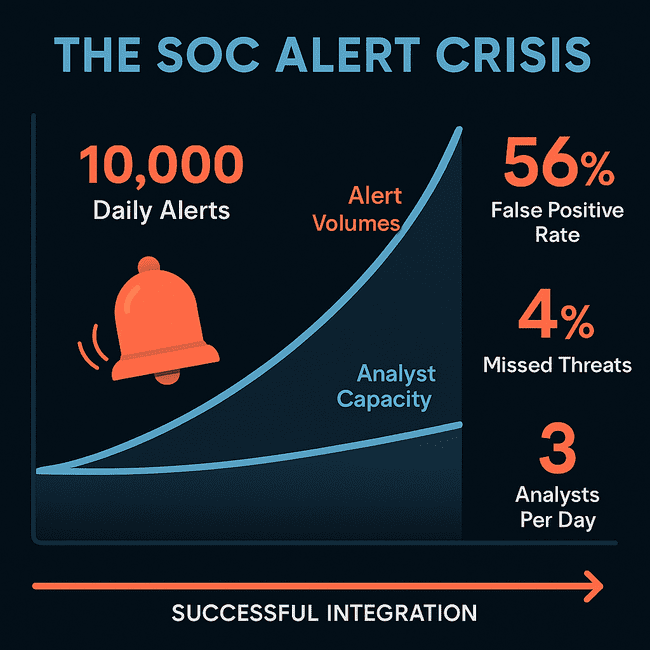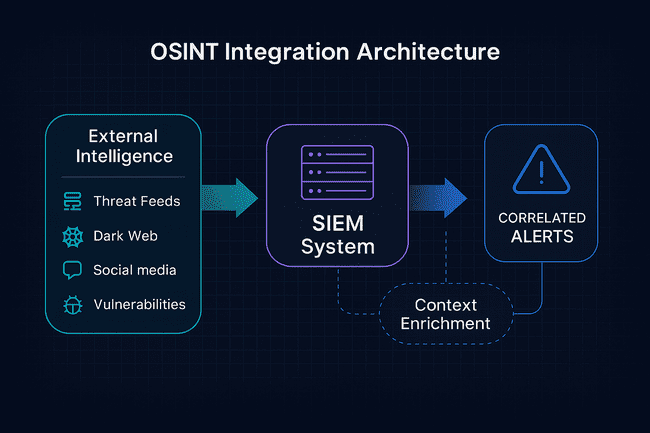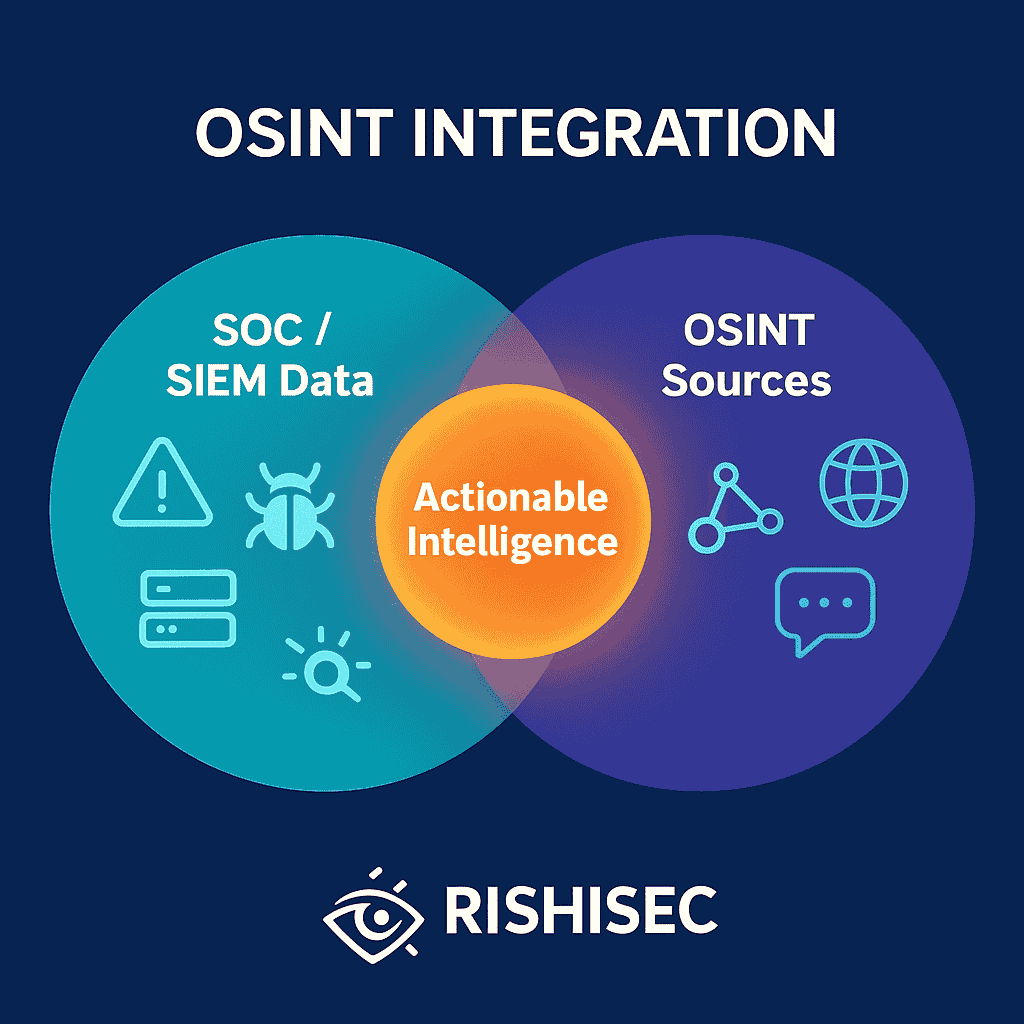The modern Security Operations Center (SOC) faces an overwhelming reality: thousands of alerts flood in daily, leaving analysts struggling to separate genuine threats from false positives. Research shows that SOC teams spend up to 80% of their time investigating alerts that prove benign, while real threats slip through undetected. The solution lies in OSINT integration, bringing Open Source Intelligence into SOC workflows to provide the missing context that transforms raw alerts into actionable intelligence.
The Alert Overload Crisis in Modern SOCs
Contemporary SOC environments generate between 10,000 and 50,000 security alerts daily. Traditional Security Information and Event Management (SIEM) systems, while essential, often create more noise than clarity. They excel at pattern matching and rule-based detection but struggle with the nuanced context required for accurate threat assessment.
This alert fatigue doesn’t just overwhelm analysts; it creates dangerous blind spots. When every alert looks equally urgent, nothing is truly urgent. Critical threats camouflage themselves among legitimate security events, while analysts burn out trying to investigate every potential incident.
The financial impact is staggering. Organizations spend millions on security tools that generate alerts, then spend millions more on analyst time investigating false positives. Meanwhile, the average data breach takes 287 days to identify and contain, often because the initial indicators were buried in alert noise.

OSINT: The Intelligence Multiplier for SOC Operations
Open Source Intelligence transforms the SOC paradigm by providing rich contextual data that turns isolated alerts into comprehensive threat narratives. Rather than reacting to individual security events in isolation, OSINT enables proactive threat hunting and intelligent alert prioritization.
OSINT leverages publicly available information, social media profiles, domain registration data, code repositories, dark web forums, threat actor communications, and geopolitical intelligence—to build comprehensive pictures of potential threats. This external context is what traditional internal security tools cannot provide.
When integrated effectively, OSINT capabilities enable SOC teams to:
Contextualize Unknown Indicators: An IP address flagged by your SIEM becomes significantly more actionable when OSINT reveals it’s associated with a known Advanced Persistent Threat (APT) group, recently mentioned in underground forums, or linked to a specific malware campaign.
Predict Attack Vectors: By monitoring threat actor discussions, security researchers can identify emerging tactics, techniques, and procedures (TTPs) before they appear in your environment. This proactive intelligence allows for preventive controls rather than reactive responses.
Validate Alert Criticality: OSINT provides the external validation needed to escalate genuine threats while deprioritizing false positives. When an alert correlates with multiple external intelligence sources, confidence levels increase dramatically.

Strategic OSINT Implementation for Alert Prioritization
Effective OSINT integration requires systematic approaches that enhance rather than complicate existing SOC workflows. The most successful implementations focus on automation and seamless integration with current security tools.
Threat Intelligence Feed Integration
Modern SOC environments benefit from automated threat intelligence feeds that continuously update indicators of compromise (IOCs) and threat actor profiles. These feeds should integrate directly with SIEM platforms, automatically enriching alerts with external context.
Platforms like Kindi excel in this integration challenge, providing automated multi-step investigations that combine internal security data with comprehensive OSINT analysis. Rather than requiring analysts to manually cross-reference external sources, intelligent automation handles the heavy lifting while presenting consolidated findings.
Automated Investigation Workflows
The most valuable OSINT implementations automate routine investigation tasks. When a suspicious IP address appears in your logs, automated systems should immediately query multiple intelligence sources: reputation databases, geolocation services, passive DNS records, and threat actor attribution databases. This automation doesn’t replace analyst expertise; it amplifies it. Instead of spending hours gathering basic information about an indicator, analysts receive comprehensive intelligence packages that enable immediate, informed decision-making.
Platforms like Kindi excel in this integration challenge, providing automated multi-step investigations that combine internal security data with comprehensive OSINT analysis. Rather than requiring analysts to manually cross-reference external sources, Kindi’s intelligent automation handles the heavy lifting, presenting consolidated findings in an intuitive dashboard.
Risk-Based Alert Scoring
OSINT enables sophisticated risk-based alert scoring that considers external threat context. An internal network scan becomes significantly more concerning when external intelligence reveals that the source IP has recently participated in credential stuffing attacks against similar organizations. Kindi incorporates OSINT-driven risk scoring that factors in external threat campaigns, recent attack activities, and industry-specific targeting trends. This allows SOC teams to move beyond binary alerts toward dynamic, context-rich prioritization.
Risk scoring algorithms should incorporate threat actor sophistication levels, recent campaign activities, geopolitical factors, and industry-specific targeting patterns. This multidimensional approach creates alert prioritization that reflects real-world threat landscapes.
Unmasking Advanced Persistent Threats Through OSINT
Advanced Persistent Threats represent the most sophisticated challenges facing SOC teams. These threat actors deliberately operate below traditional detection thresholds, using legitimate tools and techniques to avoid triggering security alerts. OSINT provides the external perspective necessary to identify APT activities.
Attribution and Campaign Tracking
OSINT excels at connecting seemingly unrelated security events to broader threat actor campaigns. Individual alerts gain significance when external intelligence reveals they’re part of coordinated attack sequences targeting specific industries or regions.
Threat actor attribution through OSINT involves analyzing infrastructure patterns, code similarities, operational security mistakes, and communication signatures. This analysis often reveals that multiple “isolated” incidents are actually components of sustained APT campaigns.
Infrastructure Analysis
APT groups maintain complex infrastructure ecosystems spanning multiple domains, IP addresses, and hosting providers. OSINT tools can map these relationships, revealing the broader attack infrastructure even when individual components appear benign.
Advanced platforms provide interactive link graphs that visualize these relationships, enabling analysts to understand attack infrastructure at scale. When one node in the network triggers an alert, the entire infrastructure becomes suspect.
Behavioral Pattern Recognition
OSINT enables pattern recognition across timeframes and attack vectors that individual security tools cannot achieve. By analyzing external threat intelligence alongside internal security data, analysts can identify subtle behavioral patterns characteristic of specific threat actors.
These patterns often involve timing sequences, target selection criteria, and operational methodologies that span months or years. Traditional reactive security approaches miss these extended campaigns entirely.
Tactical OSINT Techniques for SOC Enhancement
Practical OSINT implementation in SOC environments requires specific techniques optimized for rapid analysis and actionable intelligence. These techniques should integrate seamlessly with existing incident response procedures.
Domain and IP Intelligence Gathering
Every suspicious domain or IP address in your security logs represents an intelligence opportunity. Comprehensive domain analysis includes WHOIS history, DNS resolution patterns, SSL certificate analysis, and subdomain enumeration. This information often reveals infrastructure patterns characteristic of specific threat actors.
IP address intelligence encompasses geolocation analysis, autonomous system number (ASN) identification, and historical usage patterns. Threat actors often reuse infrastructure across campaigns, making IP analysis a valuable attribution technique.
Social Media and Digital Footprint Analysis
Threat actors maintain digital presences across social media platforms, forums, and professional networks. These footprints often contain operational security mistakes that reveal real identities, locations, or campaign planning activities.
Automated social media monitoring can identify threat actor communications, recruitment activities, and campaign announcements. This intelligence provides early warning capabilities that traditional technical indicators cannot match.
Dark Web and Underground Forum Monitoring
Cybercriminal marketplaces and forums contain advanced warnings of planned attacks, newly discovered vulnerabilities, and available attack tools. Monitoring these environments provides strategic intelligence about emerging threats.
This monitoring requires specialized tools and techniques to access dark web resources safely while maintaining operational security. The intelligence gathered often provides weeks or months of advance warning about threats that will eventually appear in traditional security feeds.

Measuring OSINT Impact on SOC Performance
Successful OSINT implementation requires measurable improvements in SOC operational efficiency and threat detection capabilities. Key performance indicators should reflect both operational metrics and security outcomes.
Alert Quality Metrics
The primary measure of OSINT success is improved alert quality rather than alert quantity. Effective OSINT implementation should increase the percentage of high-fidelity alerts while reducing time spent investigating false positives.
Mean time to detection (MTTD) and mean time to response (MTTR) metrics should improve as analysts receive better contextual information. When alerts include comprehensive external intelligence, investigation times decrease while confidence levels increase.
Threat Detection Improvements
OSINT should enhance threat detection capabilities by identifying threats that traditional tools miss. This includes advanced persistent threats, zero-day exploits, and sophisticated social engineering campaigns.
Success metrics include increased detection of advanced threats, improved threat actor attribution accuracy, and reduced dwell time for sophisticated attacks. These improvements directly translate to reduced organizational risk.
Analyst Productivity Enhancement
OSINT tools should amplify analyst capabilities rather than create additional workload. Productivity metrics include reduced investigation time per alert, increased number of high-quality investigations per analyst, and improved job satisfaction scores.
Effective OSINT implementation enables analysts to focus on high-value activities like threat hunting and strategic analysis rather than routine indicator research.
The Future of OSINT-Enhanced SOC Operations
The evolution of OSINT capabilities continues to accelerate, with artificial intelligence and machine learning enhancing both data collection and analysis capabilities. Future SOC environments will increasingly rely on automated intelligence gathering and analysis.
Emerging technologies enable real-time threat landscape analysis, predictive threat modeling, and automated threat actor profiling. These capabilities transform SOC operations from reactive security monitoring to proactive threat management.
Organizations implementing comprehensive OSINT capabilities today position themselves for future security challenges while immediately improving their threat detection and response capabilities.
Conclusion: Transforming SOC Effectiveness Through Strategic OSINT
The integration of Open Source Intelligence into SOC operations represents a fundamental shift from reactive alert management to proactive threat intelligence. Organizations that successfully implement OSINT capabilities report dramatic improvements in threat detection accuracy, analyst productivity, and overall security posture.
The key to success lies in selecting platforms that seamlessly integrate external intelligence with existing security infrastructure. Tools like Kindi demonstrate how automated OSINT capabilities can transform overwhelming alert streams into actionable threat intelligence, enabling SOC teams to focus their expertise where it creates maximum impact.
As threat actors continue evolving their techniques and the attack surface expands, OSINT provides the external perspective necessary to stay ahead of emerging threats. The question for SOC leaders isn’t whether to implement OSINT capabilities, but how quickly they can transform their operations to leverage this powerful intelligence methodology.
Ready to transform your SOC’s alert prioritization capabilities? Explore how Kindi’s OSINT automation empowers analysts to cut through alert noise and unmask real threats. [Request a Demo] or download our comprehensive guide “Advanced OSINT Techniques for SOC Teams.”




